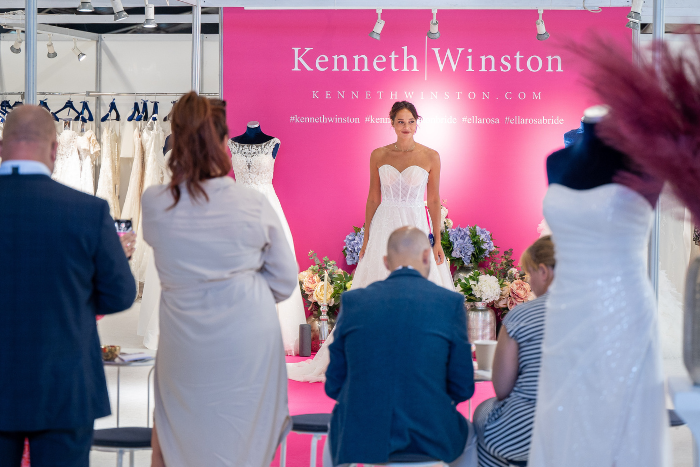The 'Six Thinking Hats' for Success
Maria Musgrove-Wethey from Get Savvy Academy explains how you can adopt Edward de Bono’s ‘Six Thinking Hats’ as a tool for problem-solving within your bridal boutique.
As bridal boutique owners we’re all very familiar with wearing different hats. These range from agony aunt to accountant, buyer to blogger, cleaner to confidante, debt collector to designer, maintenance to marketeer, interior designer to IT troubleshooter, social media to sales, waitress to window dresser, and so it goes on! As if that’s not enough hats to wear, this article introduces Edward de Bono’s ‘Six Thinking Hats’. This is designed to help if we’ve got a bit stuck thinking about a problem or when we can’t reach an agreement with our team.
This could be in the boutique choosing a new paint colour, or deciding whether to charge for appointments, or at Harrogate deliberating whether or not to take on or drop a designer, or even something as mundane as shall we book a hotel or an apartment. Instead of donning the role of referee with whistle and cards, you might think of metaphorically donning De Bono’s ‘Six Thinking Hats’ instead as a way of reaching consensus and avoiding an argument.
What is it?
‘Six Thinking Hats’ was developed by internationally respected consultant Edward de Bono. The technique is based on the idea that there are six imaginary hats. Each hat is a different colour and represents a different type of thinking. When you ‘put on’ a hat, you operate exclusively in that mode of thinking. When you change from one hat to another, you change thinking modes.
What do the different hats represent?
De Bono chose six hats to cover the different approaches to thinking he had identified and gave them a different colour to allow easy association and visualisation. Each coloured hat represents a particular type of thinking, each with its own ‘rules’ about that type of thinking.
- The White Hat – facts and information known as ‘The Detective’. This is all about factual, observable data. It looks at what is known and what information could be missing.
- The Red Hat – feelings and intuition known as ‘The Heart’. This is about feelings, insights and intuition. It focuses on what people feel about the issue under discussion and there’s no need to rationalise or explain.
- The Yellow Hat – benefits and advantages known as ‘The Sun’. Optimism is represented here. The team all think about the possible benefits and opportunities an idea can present.
- The Black Hat – caution and problems known as ‘The Barrister’. The opposite of the Yellow Hat. The focus here is on problems, risks, and challenges that this idea might pose.
- The Green Hat – creativity and solutions known as ‘The Seedling’. Representing new growth, this hat asks the team to consider new approaches and is often used when brainstorming.
- The Blue Hat – managing thinking known as ‘The Movie Director’. For blue-skies and oversight. Unlike all the other hats, this hat is only worn by the person who chairs the discussion and ensures everyone wears the right hat at the right time, asks the right questions, and pulls out the conclusions.
How does it work?
‘Six Thinking Hats’ requires everyone taking part in a discussion to ‘put on’ the same hat at the same time and only use that hat at that time. By moving through the different ways of thinking a more rounded approach is taken to appraising an idea. De Bono emphasised that ‘Six Thinking Hats’ was about modes of behaviour and not individual personalities. Of course, many people prefer certain types of thinking.
When would you use it?
It’s quite common when you are looking for new ideas that there can be a tendency towards Black Hat thinking. People concentrate on the problems to doing something new or different. “That will never work” or “Our procedures don’t allow that to happen.” They then get stuck in a rut, always concentrating on the “Why we shouldn’t” and as a result nothing changes. ‘Six Thinking Hats’ is a great tool for recognising when a group of people have fallen into 1-hat thinking and the discussion is going nowhere.
Instead of falling out with each other, throwing in the towel or disregarding others’ opinions in sheer frustration, you could don The Blue Hat and move your team onto a different hat to open up the discussion. Good questions to break the Black Hat way of thinking would be from the Yellow Hat “What opportunities could this present?”, “What are the advantages of working in this way instead?” and “Are there any benefits?”
When Christine Sinclair and I were setting up Get Savvy we realised that my tendency to Black and Red Hat thinking with the focus on problems and gut feelings was getting in the way of Christine’s creative Green Hat thinking. Once we identified our preferences we became much more productive and by putting on different hats and asking some of the questions associated with each, we had a different perspective.
If you’d like a different perspective on your business, then Get Savvy Membership 2021 is opening soon. Get yourself on our VIP waiting list here and be one of the first to know when we open our doors for membership.






